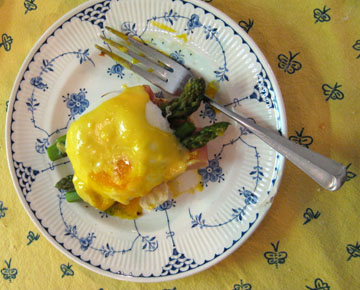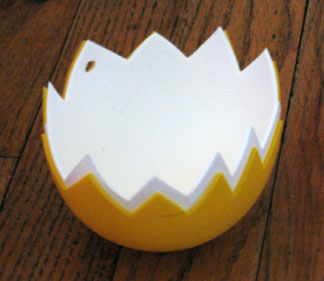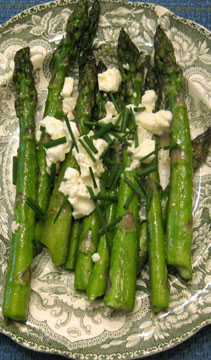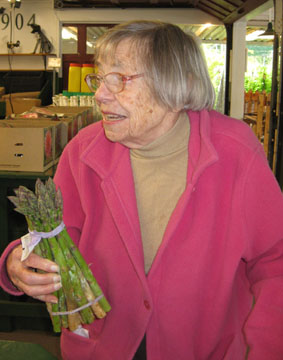
Here’s another recipe for my beloved Sparrow Grass–or perhaps I should say Spearage, which according to Kathleen Wall at Plimoth Plantation was a common 17th-century term for asparagus.
I’m not a big Eggs Benedict Girl—the consistency of the ham never seems to me to go with the rest of the ingredients—but alter the recipe a little and incorporate asparagus and I’m hooked. (You may of course add ham as well!)
I’m always a little cautious about poaching eggs, but I found a helpful new product at the Lamson & Goodnow retail store in Shelburne Falls, Massachusetts, that banishes my fears. It’s called an eggshell™ and comes in packages of two that look like little cracked eggs.
To use one of these silicone products, lightly grease the inside, pop your egg into it, and float the eggshell in boiling water. Cover the pot, and cook for 5 minutes. Your poached egg pops easily out of the silicone and onto your English muffin.
Ingredients:
for the Hollandaise sauce (makes about 1 cup of sauce):
1/2 cup (1 stick) sweet butter
3 egg yolks
the juice of 1/2 small lemon
2 tablespoons hot water
a pinch of cayenne pepper
a pinch of salt
for assembly (per person):
1/2 English muffin
butter as needed for the muffins
1 slice Prosciutto (optional)
3 spears cooked asparagus (either whole or cut up)
1 poached egg
a generous dollop of Hollandaise sauce
salt and pepper to taste
Instructions:
First, make the Hollandaise sauce. Melt the butter in a saucepan. In the top of a double boiler over warm (but not boiling!) water, whisk the egg yolks until they are smooth. Whisk in the lemon juice. Slowly whisk in the butter in a thin stream.
Slowly stir in the hot water, cayenne, and salt, and cook for 1 minute more, whisking constantly. Set the sauce aside while you poach the eggs and cook the toast.
For each person, butter half of a toasted English muffin, and lay the Prosciutto on top if you want to use it. Depending on your preference, put the asparagus on next or the egg (my mother and I liked it both ways!).
Cover with a little Hollandaise sauce, and season to taste. Serve immediately. One recipe of Hollandaise makes enough sauce for 4 to 6 eggs.

The Eggshells




